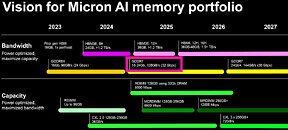- Joined
- Oct 9, 2007
- Messages
- 47,528 (7.48/day)
- Location
- Hyderabad, India
| System Name | RBMK-1000 |
|---|---|
| Processor | AMD Ryzen 7 5700G |
| Motherboard | ASUS ROG Strix B450-E Gaming |
| Cooling | DeepCool Gammax L240 V2 |
| Memory | 2x 8GB G.Skill Sniper X |
| Video Card(s) | Palit GeForce RTX 2080 SUPER GameRock |
| Storage | Western Digital Black NVMe 512GB |
| Display(s) | BenQ 1440p 60 Hz 27-inch |
| Case | Corsair Carbide 100R |
| Audio Device(s) | ASUS SupremeFX S1220A |
| Power Supply | Cooler Master MWE Gold 650W |
| Mouse | ASUS ROG Strix Impact |
| Keyboard | Gamdias Hermes E2 |
| Software | Windows 11 Pro |
Some of the first gaming GPUs that implement the next-generation GDDR7 memory standard, will stick to 16 Gbit memory chip densities (2 GB), according to kopite7kimi, a reliable source with NVIDIA GeForce leaks. 16 Gbit is what is standard for the current RTX 40-series graphics cards, which ensures that a GPU with 256-bit memory bus gets 16 GB of video memory; the ones with 192-bit get 12 GB; and the ones with 128-bit get 8 GB. The flagship RTX 4090 uses twelve of these chips over its 384-bit memory bus for 24 GB.
Kopite7kimi's leak could have a different connotation, that much like the RTX 30-series "Ampere" and RTX 40-series "Ada," NVIDIA might not use JEDEC-standard GDDR7 on all product segments, and might co-engineer an exclusive standard with a DRAM company with memory bus signaling and power management technologies most optimal to its graphics architecture. It co-developed the GDDR6X with Micron Technology to do exactly this. GDDR7 comes with data-rates as high as 32 Gbps, which will be the top speed for the first round of GDDR7 chips that come out toward the end of 2024, heading into 2025. The second round of GDDR7 chips slated for late-2025 going into 2026, could go as fast as 36 Gbps. This is similar to how the first GDDR6 chips were 14-16 Gbps, and the next round did 18-20 Gbps.

Another very interesting development is a 3DCenter.org article that reports that GDDR7 will see asymmetric densities such as 24 Gbit and 48 Gbit. A 24 Gbit density GDDR7 chip has 3 GB, which over a 192-bit memory bus gives 18 GB; over a 256-bit memory bus yields 24 GB; and over a 128-bit memory bus yields 12 GB. Assuming GPU manufacturers want to keep board costs low, and narrow the memory bus width to take advantage of the 32 Gbps speed; they now have the option of using these 24 Gbit chips to make up for in video memory sizes. Of course, the GDDR7 standard has higher densities, such as 32 Gbit or even 64 Gbit, but those will be exotic, expensive, and be restricted to the professional-visualization market—think RTX Blackwell Generation or Radeon Pro RDNA 4.
View at TechPowerUp Main Site | Source
Kopite7kimi's leak could have a different connotation, that much like the RTX 30-series "Ampere" and RTX 40-series "Ada," NVIDIA might not use JEDEC-standard GDDR7 on all product segments, and might co-engineer an exclusive standard with a DRAM company with memory bus signaling and power management technologies most optimal to its graphics architecture. It co-developed the GDDR6X with Micron Technology to do exactly this. GDDR7 comes with data-rates as high as 32 Gbps, which will be the top speed for the first round of GDDR7 chips that come out toward the end of 2024, heading into 2025. The second round of GDDR7 chips slated for late-2025 going into 2026, could go as fast as 36 Gbps. This is similar to how the first GDDR6 chips were 14-16 Gbps, and the next round did 18-20 Gbps.

Another very interesting development is a 3DCenter.org article that reports that GDDR7 will see asymmetric densities such as 24 Gbit and 48 Gbit. A 24 Gbit density GDDR7 chip has 3 GB, which over a 192-bit memory bus gives 18 GB; over a 256-bit memory bus yields 24 GB; and over a 128-bit memory bus yields 12 GB. Assuming GPU manufacturers want to keep board costs low, and narrow the memory bus width to take advantage of the 32 Gbps speed; they now have the option of using these 24 Gbit chips to make up for in video memory sizes. Of course, the GDDR7 standard has higher densities, such as 32 Gbit or even 64 Gbit, but those will be exotic, expensive, and be restricted to the professional-visualization market—think RTX Blackwell Generation or Radeon Pro RDNA 4.
View at TechPowerUp Main Site | Source




